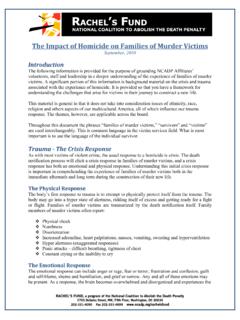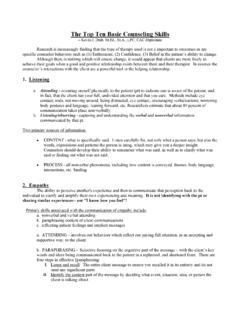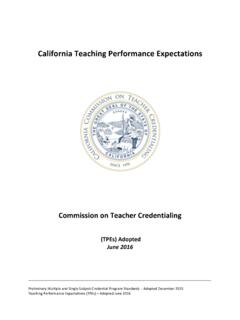Transcription of Promoting Self-Regulation in the First Five Years: A ...
1 1 Promoting Self-Regulation in the First Five Years: A Practice Brief Early childhood is a period of rapid brain development that paves the way for growth of Self-Regulation skills. This brief builds on reviews of the theoretical and intervention literature to provide early childhood leaders such as program administrators with guidelines for Promoting Self-Regulation development in children aged birth through 5 years, both programmatically and through supportive environmental contexts. The brief is based on work conducted by the Duke Center for Child and Family Policy for the Administration for Children and Families (ACF), described in a series of four reports referenced throughout the brief, which can be accessed online at Self-Regulation : What is it and why is it important? Self-Regulation has a foundational role in Promoting wellbeing across the lifespan, including physical, emotional, social, and economic health and educational achievement.
2 Self-Regulation can be defined as the act of managing thoughts and feelings to enable goal-directed actions. This means, for instance, finding ways to cope with strong feelings so they don t become overwhelming; learning to focus and shift attention; and successfully controlling behaviors required to get along with others and work towards goals. Supporting Self-Regulation development in early childhood is an investment in later success, because stronger Self-Regulation predicts better performance in school, better relationships with others, and fewer behavioral difficulties. Moreover, the ability to regulate thoughts, feelings, and actions helps children successfully negotiate many of the challenges they face, Promoting resilience in the face of adversity (For more information, see Report 1: Foundations for Understanding Self-Regulation from an Applied Developmental Perspective, ) Self-Regulation is recognized as one of the key areas of early child development in the Head Start Early Learning Outcomes Framework (Administration for Children and Families, 2015: ), where skills related to Self-Regulation are woven into both the Approaches to Learning and the Social/Emotional Development domains.
3 The information in this brief and the referenced reports can be used to complement that of the Head Start Framework, providing an overview of child skills and caregiver practices that are key in the development Self-Regulation . By proactively teaching and supporting Self-Regulation skills across settings, we can help children from all backgrounds enter kindergarten ready to learn. 2 How does Self-Regulation develop? As depicted in the figure, multiple layers of factors contribute to Self-Regulation , from biological predisposition to caregiver support and environmental context. While biology sets the stage for Self-Regulation readiness, more complex skills and motivation for Self-Regulation develop through interaction with caregivers and the broader environment over an extended period from birth through young adulthood (and beyond). In infancy, the brain is primed to create connections that support the beginnings of Self-Regulation .
4 Across early childhood, brain-based capacity for Self-Regulation increases rapidly. Just like with literacy or math, however, this capacity will not be fully realized without support from the environment. For literacy, young children need exposure to print materials in the environment, combined with active instruction, support, and practice. Self-Regulation is much the same: children learning Self-Regulation skills need structured environments, supportive relationships, and direct instruction and coaching in a progression of Self-Regulation skills. Just as with literacy, there will be individual differences in development that require different levels of support. For instance, some children may be more temperamentally sensitive and thus more easily overwhelmed by sensory input. Other children may experience more stressors in their environments. Both of these situations can make it harder for children to self-regulate. Nevertheless, with intervention and support aligned with their level of need, children can effectively build skills to manage their thoughts, feelings, and behaviors.
5 For more information on Self-Regulation development, visit Report 1 in this series: Foundations for Understanding Self-Regulation from an Applied Developmental Perspective, What are the benefits of focusing on Self-Regulation development in early childhood? Humans learn more quickly during their First few years than at any other time in their lives. Experiences, particularly those with significant others like caregivers and siblings, literally wire the brain s architecture , laying the foundation for what is to come (see Harvard s Center on the Developing Child for more information: ). Intentional work by adults to promote Self-Regulation capacity early in the lives of children can help them to develop critical skills like attentional control, problem-solving, and coping strategies for managing distressing environmental or emotional experiences. Capitalizing on the developmental readiness of the earliest years, approaches that systematically combine interventions with supportive caregivers and environments can proactively foster Self-Regulation skills and help children enter kindergarten ready to learn.
6 Factors Contributing to Self-Regulation Enactment supportsBiology 3 This is not to say that early childhood is the only opportunity for Self-Regulation intervention indeed, Self-Regulation continues developing at least through young adulthood, if not across the lifespan. However, laying the foundation early may prevent childhood struggles, avoiding later need for more intensive interventions, and thus may prove more cost-effective in the long run. How important are parents and other caregivers in the development of Self-Regulation ? There is a well-established link between parenting and the development of Self-Regulation in childhood, summarized in Report 2: A Review of Ecological, Biological, and Developmental Studies of Self-Regulation and Stress, As indicated by almost 50 studies identified in a comprehensive literature review, parental warmth, responsiveness, and sensitivity support Self-Regulation development and may buffer the effects of other stressors in the family and environment.
7 Parents are not the only caregivers shaping the lives of young children, however. Child care providers, preschool teachers, extended family members, and other adults who spend significant time caring for children can be instrumental in supporting their development of Self-Regulation . During the First years of life, caregivers are particularly central to development. Young children are dependent upon their caregivers to create a safe, nurturing, and appropriately stimulating environment so they can learn about the world around them. There are three broad categories of support that caregivers can provide to young children to help them develop the foundational self-regulatory skills that they will need to get the best start in life. Together, these describe the supportive process of co-regulation between adults and children: Provide a warm, responsive relationship where children feel respected as individuals, comforted and supported in times of stress, and confident that they will be cared for no matter what.
8 This positive relationship will promote self-efficacy and allow children to feel secure enough to practice new skills and learn from mistakes. Structure the environment to make Self-Regulation manageable, providing a buffer against environmental stressors. This means creating an environment that is physically and emotionally safe for children to explore and learn at their level of development without serious risk to their wellbeing. Consistent, predictable routines and expectations likewise promote a sense of security by providing clear goals for behavior regulation. Teach and coach Self-Regulation skills through modeling, instruction, opportunities for practice, prompts for skill enactment, and reinforcement of successive approximations. Like a coach on a sports team, caregivers should First instruct children in skills, and then provide needed supports, or scaffolding, for Self-Regulation enactment in the moment. 4 Co-regulation will look different at different ages as children s capacity for Self-Regulation grows, but remains a critical component of Self-Regulation across development.
9 Caregiver capacity for co-regulation will depend, in large part, on that caregiver s own Self-Regulation skills. Young children are incredibly sensitive to the emotions and behaviors of adults. Adults who are themselves feeling overly stressed may have a harder time calming a young child and, thus, may actually increase that child s agitation, which in turn makes it harder to soothe them. Caregivers who focus on improving their own coping and calm-down skills will build their own Self-Regulation , provide a more calming influence to children in their care, and be better able to teach these same skills to children as they grow. What does Self-Regulation look like during early childhood? Self-Regulation skills and capacity change considerably over the First five years of life, based in part on cognitive and motor skill development. Here are examples of Self-Regulation skills that children might be ready for, by developmental age group.
10 In infancy: Shifting attention or averting gaze when overwhelmed Self-soothing by sucking fingers or a pacifier to reduce distress In toddlerhood: Focusing attention for short periods Adjusting behavior to achieve goals Beginning to label feelings Briefly delaying gratification Turning to adults for help with strong feelings In preschool-aged children: Recognizing a growing array of feelings in self and others Identifying solutions to simple problems With support, using strategies like deep breaths and self-talk to calm down Focusing attention and persisting on difficult tasks for increased lengths of time Perspective-taking and early empathy What does effective co-regulation look like during early childhood? Just as child Self-Regulation skills change as they grow and develop, so do their needs for co-regulation support from their caregivers. In infancy, babies require adults to manage a large portion of their regulatory needs, from feeding to temperature control to management of environmental stimuli.













